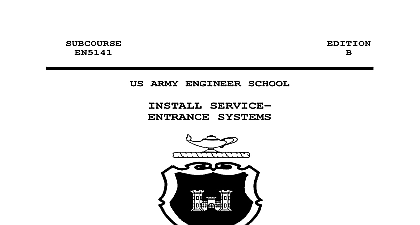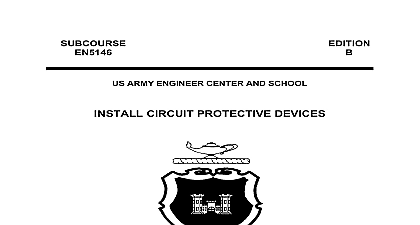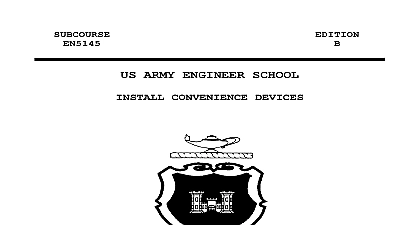INSTALL SYSTEM EQUIPMENTAND COMPONENT GROUNDS

File Preview
Click below to download for free
Click below to download for free
File Data
| Name | install-system-equipmentand-component-grounds-1670239854.pdf |
|---|---|
| Type | |
| Size | 2.02 MB |
| Downloads |
Text Preview
SUBCOURSE ARMY ENGINEER SCHOOL SYSTEM EQUIPMENT COMPONENT GROUNDS SYSTEM EQUIPMENT AND GROUNDS Number EN 5144 B States Army Engineer School Leonard Wood Missouri 65473 Credit Hours Date October 1999 OVERVIEW subcourse is designed to teach the knowledge necessary to install grounding electrodes and circuit The subcourse contains two lessons relating to Soldier Training Publication STP 5 51R12 Task 051 246 1104 Install Grounding Systems Equipment and Component Grounds are no prerequisites for this subcourse subcourse reflects the doctrine which was current at the time it was prepared In your own work always refer to the latest official publications otherwise stated the masculine gender of singular pronouns is used to refer to both men and publication contains copyrighted material A contains a metric conversion chart LEARNING OBJECTIVE will describe the procedures used to install grounding systems will be given the material in this subcourse a number No 2 pencil and an Correspondence Course Program ACCP examination response sheet demonstrate competency of this task you must achieve a minimum of 70 percent this subcourse 2 1 page 2 4 Table 2 2 page 2 5 and Table 2 3 page 2 8 were extracted from the National Code NEC printed and distributed by the National Fire Protection Association OF CONTENTS Overview i Instructions iii and Certification Instructions iii 1 Install Grounding Electrodes 1 1 Exercise 1 13 Key and Feedback 1 16 2 Install Circuit Grounds 2 1 Exercise 2 11 Key and Feedback 2 14 A Metric Conversion Chart A 1 B List of Common Acronyms B 1 C Recommended Reading List C 1 Inquiry Sheets PAGE INTENTIONALLY LEFT BLANK PAGE IS INTENTIONALLY LEFT BLANK 1 GROUNDING ELECTRODES Task 051 246 1104 this lesson you will learn to describe the procedures used to install grounding electrodes DESCRIPTION LEARNING OBJECTIVE will learn to describe the procedures used to install grounding electrodes will be given the material contained in this lesson You will work at your own and in your own selected environment with no supervision will correctly answer the practice exercise questions at the end of this lesson The material contained in this lesson was derived from STP 5 51R12 SM TG and 250 of the NEC electrician most important concern is to ensure that all electrical circuits are grounded In this you will be shown how to properly select and place grounding electrodes As an electrician you be able to install and test electrical circuits to ensure that you have a proper ground Systems Grounding systems are installed using grounding rods conductors or plates Grounding must be copper steel or iron steel galvanized pipe that is at least 8 feet long Ground resistance be less than 25 ohms to ground earth In order to get resistance below 25 ohms to ground you need to drive a ground rod deeper than 8 feet install additional rods or add chemicals to the soil water pipes can be used to supplement a grounding system One of the most important parts of installation is the grounding rod Figure 1 1 page 1 2 5144 1 1 Grounding rod The best grounding rod electrode is made of copper nonferrous metal and is at least 1 2 in diameter Figure 1 2 1 2 Copper grounding rod A copper coated steel grounding rod is at least 1 2 inch in diameter Figure 1 3 1 3 Copper coated steel grounding rod A solid steel ferrous metal grounding rod is at least 5 8 inch in diameter Figure 1 4 1 4 Solid steel grounding rod An iron steel galvanized grounding rod is at least 3 4 inch in diameter Figure 1 5 1 5 Iron steel galvanized grounding rod For ease of storing some grounding rods are constructed in 3 foot sections Figure 1 6 1 6 Grounding rod sections Installing Grounding Rods Grounding rods are driven into the earth to a depth of at least 8 feet 1 7 This should reach the moisture level in most areas 1 7 Depth of grounding rod rock is hit at less than 8 feet the grounding rod can be driven at an angle but the angle exceed 45 degrees Figure 1 8 1 8 Grounding rod driven at an angle A grounding rod can also be buried on top of rock in a trench that is 2 1 2 feet deep and 8 long Figures 1 9 and 1 10 1 9 Grounding rod buried on top of rock 1 10 Cutting a trench Ground clamps Figure 1 11 hold the ground conductor and the grounding rod together losing conductivity when exposed to weather and abuse Ensure that the ground conductor is to the screw on clamp The upper end of the grounding rod must be flush with or below level unless the connection is protected against physical damage 1 11 Ground clamps Resistance The resistance between a grounding rod and the earth should be less than 25 ohms the ground resistance with a megohm meter Figure 1 12 This check should be made with the jumper between the water pipe or a good ground and the electrical system A metallic cold system makes a good point for testing the resistance of an electrical grounding system If 25 ohms ground cannot be achieved take the following actions 1 12 Megohm meter Drive additional 8 foot grounding rods into the earth and bond them together The rods must at least 6 feet apart Figure 1 13 1 13 Additional grounding rods Drive grounding rods deeper if necessary to reach the water table Figure 1 14 1 14 Grounding rod reaching the water table Treat the soil with chemicals if the ground resistance is still over 25 ohms after using the described in paragraphs 1 3a and 1 3b Treat the soil by Digging a circular trench around the grounding electrode The trench should be 1 foot deep 9 inches away from the electrode Figure 1 15 Filling the trench with 50 to 100 pounds of rock salt copper sulfate or magnesium sulfate also be used and then filling the trench with water As the water goes through the salt the ground resistance should be lowered Natural rainfall will continue the process but must replace the rock salt every two years Figure 1 16 1 15 Trench dug around grounding rod 1 16 Trench filled with rock salt Grounding Plates Grounding plates Figure 1 17 are sometimes required by a construction print offer a better grounding system than grounding rods and are generally used in permanent and computer sites Unless prints or specifications call for larger plates the total surface of grounding plates must be 2 square feet 1 17 Grounding plate or steel grounding plates must be at least 1 4 inch thick Figure 1 18 1 18 Iron or steel grounding plate Nonferrous copper or brass groundi


